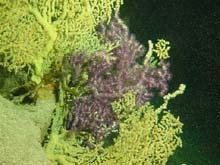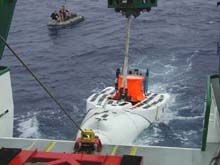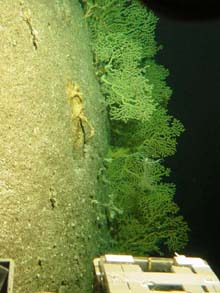
A gorgeous purple coral grows over gold coral, which always grows over bamboo coral. Click image for larger view.
The Search for Golden Coral
September 22, 2002
Rachel Shackelford, Data Manager
Hawaii Undersea Research Lab
We finally found a bed of gold coral -- a big one, on a sheer vertical cliff. Throughout our exploration of the Northampton Seamounts, we keep hoping to find a significant field of precious coral that might harbor eels and other fish, making it a good foraging ground for monk seals. Until yesterday, we hadn't seen anything that even came close.
Before we started diving here, fisheries biologist Frank Parrish had some doubts as to what we would find. When monk seals pointed him to fields of gold coral at East French Frigate Shoals (EFFS), their message had been much clearer. Satellite tracking data showed a few monk seals repeatedly visiting one specific area. In the case of Northampton, tracking data show that the seals visit these seamounts, but their dives are much more scattered. So we knew that the chances of finding an important foraging ground were slim, at best. But that is what exploration is about. Still, as the submersible and remotely operated vehicle (ROV) dives revealed sandy fields and carbonate ledges devoid of many fish or coral at seal foraging depths, we couldn't help but be a little disappointed.
It seems that the main culprit behind the lack of coral beds is sand. Everywhere we went, a dusting to a few inches of sand covered the rocks. For coral to grow, it needs something solid to which it can attach. Even in the rocky areas, sand might periodically travel through with the current, scouring the surface and preventing corals from growing. Yesterday's coral field was on a sheer cliff where no sand could gather. The currents were ripping by the cliff, and gold coral branches waved in the liquid “wind.”
In amongst the forest of gold coral, the sub pilot managed to get a sample of a beautiful purple coral (we aren't sure what it is) growing over a dead gold coral branch. It is kind of ironic to see a coral growing like a parasite on gold coral, since gold coral is itself a parasite that grows over bamboo coral! The coral was limited to that one current-swept cliff; none was to be seen on either side of it. Interestingly, few fish and eels were seen in association with the coral, so it is hard to tell if it would make a good foraging ground for monk seals or not. Perhaps the kahala (a vicious amber jack) and the monk seals are eating all the fish before we can see them.
The relentless current managed to pin the Picses IV against the cliff, as described in the following essay. In trying to fight the currents, the sub's batteries ran down and the dive had to be terminated before all of the transects had been completed.

The Pisces IV launches into the ocean. This was the first dive of the expedition on the Northampton Seamounts, and the weather was ugly. Click image for larger view.
Pinned!
Ray Boland, Biologist
National Marine Fisheries Service
It was a sheer wall, and we were pinned against it. The wall started at 1,800 ft and extended to . . . we never made it that far. We had wandered into a bed of gold coral, whip corals and a reddish coral called Leiopathes. The wall went straight up and down, with an undercut here, a small slope and ledge there, but for the most part, it was vertical. We were at 1,465 ft when a strong current along the wall quickly came up. We had been ascending at a slope while facing the wall. The current caught the Picses IV submersible and spun it to its port side. It wasn't very quick, since few things happen quickly underwater. Terry, the pilot, had time to react. To protect the port thruster from being crushed between the sub and the wall, he grounded the collection basket's port corner against the wall. Then he gave full throttle forward to the starboard thruster. The sub's spin to port halted.
“C'mon,” groaned Terry. He throttled back on the starboard thruster; the sub began to spin again. He throttled back up to full power. The sub's movement stopped. There we hung in the black water, our basket against the wall, our starboard thruster on full forward. The force of the current pushed against us, the thruster held us in place. Neither force was stronger than the other to pivot the sub into or away from the wall.
Terry watched for another minute, then grunted. “Maybe we need to give it some time. The thruster should eventually swing us around.”
He sat up from his hunched-over piloting position. “Let's eat lunch.”

The vertical wall covered with gold coral against which the Pisces IV submersible temporarily got pinned. The sub's sampling basket can be seen in the foreground. Click image for larger view.
The galley crew had packed our lunches for us. It was always a peanut butter and jelly sandwich, an apple, cheese and crackers and various little chocolate candy bars. The candy bars never lasted long in my bag. I always nibbled between surveys. Nothing to drink, though, because we eschewed anything that would encourage the need to use the bathroom. We sat there for about 15 min, eating lunch while the starboard thruster whined away.
About 20 min later, nothing had changed. We were still pinned by our basket, and nothing but blackness extended above us, behind us and in front of us. The wall extending along our left was our only reference.
“Suckin' dog,” murmured Terry.
How about we put all the weight forward? asked Frank, as he scooched up toward his viewport. He motioned for me to do the same, and I did. The sub shifted minutely forward, against the current.
Terry consulted the cameras, panning them toward the wall and as far back as they could go. From what he saw, it looked like the sub was only pinned by the basket.
“Well, I guess we can try pulling away from the wall again,” he said.
He goosed the port thruster to full reverse. The sub sat there. Sand blasted out of cracks in the wall. Then, at the pace of a snail with a bad foot, the sub began to swing away. We hadn't gained ground; the current had slowed. The sub pivoted on its basket and then pointed toward the wall. We began to slide along it. Terry switched the starboard thruster into reverse and the sub backed away from the wall, just as a gold coral brushed beneath our basket. We were free.
The rest of the day was fraught with current fighting that seemed to be localized. At one point, we were blown down 300 ft, despite the thrusters being angled up and at full power. We had to end the dive an hour early, because the currents had nearly exhausted our batteries. We were pretty tired, too.
Sign up for the Ocean Explorer E-mail Update List.




















